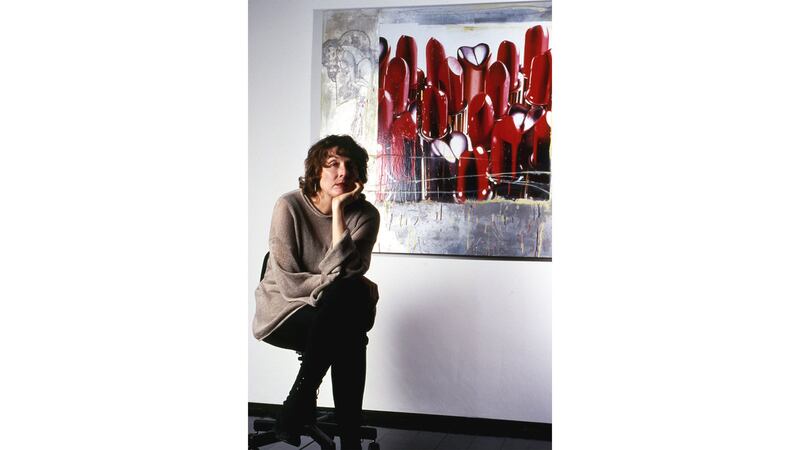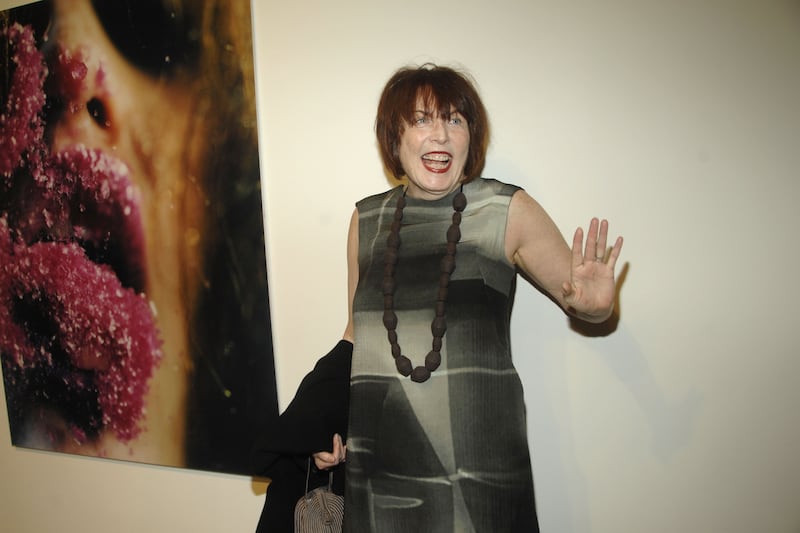When The Daily Beast reached Marilyn Minter by phone in her studio, a deafening metallic screeching sound in the background threatened to drown out the first few minutes of our conversation. “We’re manufacturing a fountain,” Minter explained. “A video fountain. You’ll see it in my next show.”
At 74, Minter, a visual artist whose radically sensual work has been tantalizing and ticking people off for decades, is hustling, and has the accolades and cultural clout to prove it.
There’s a romantic, heady dreaminess to her contemporary paintings and photographs, many of which feature women in the nude bathed in hues of lavender or gold. Dripping liquid and steam ooze from tight close-ups of eyelashes and orifices, and mouths in her work are often biting down on beads or clusters of sticky pearls. Each image leaks indulgence and gleeful, sometimes mud-splattered mess.
In 1998, Minter was awarded a high-profile Guggenheim Fellowship. Her appearance in the 2006 Whitney Biennial, considered her “return to prominence,” led up to her first retrospective Pretty/Dirty, which made it to the Brooklyn Museum in 2016.
There, this reporter snapped a photo of one of her photos, in which glistening, red-nailed fingers pinch a spray of inky black pubic hair, and shared it on Instagram. Minter, who teaches at the graduate level at New York’s School of Visual Arts, got the idea to focus on pubic hair after the subject came up in one of her classes.
“All these girls were saying that they were lasering off all their hair,” Minter said. “So then I thought, well, I’ll make pictures of what pubic hair looks like, because they haven’t seen it! I mean, there are boys that have never seen it.”
“She is a filthy sensualist, just like God,” punk rocker Richard Hell once wrote of Minter, approvingly.
“Artists are pretty delusional,” Minter told The Daily Beast. “They have to be. And they have to be totally self-involved and they have to be obsessive.”
Minter herself sounds anything but delusional—she’s candid and hilarious and blissfully married to an ex-stockbroker who manages the business side of her career, so she can feel free to just create. They live in Cold Spring, NY. She was never once interested in having children: “With my generation, we got birth control for the first time and we went wild. We tried to be like the boys.”
Because of the nature of her work, she gets a lot of probing questions. “I’m a sexual creature,” she said. “People always ask me about my sex life, and I think I have a healthy one, but I don’t think it’s abnormal. Nobody has politically correct fantasies, and I don’t have any shame about that.”
Born in Shreveport, Louisiana, Minter grew up an unfettered “wild child,” eager to contradict her mother, in South Florida. “There were a lot of kids like me,” she said. “We ran wild. We just ran wild. We had no parental guidance whatsoever.”
While studying photography and painting at the University of Florida and Syracuse in the 1970s, Minter was drawn, inexorably but not entirely consciously, towards the monstrous contradictions of femininity.

Marilyn Minter poses in front of one of her paintings of lipstick in 1995 in New York City, New York.
Catherine McGann/Getty ImagesThroughout a decades-long career packed with prestigious exhibitions and occasionally pockmarked by backlash, she’s never abandoned her feminist impulse to capture women in exaggerated states of realism or glamorous, stickily alien unreality. The tension in her work between extreme beauty and chaos has landed her gigs with Marc Jacobs, Tom Ford, Kiehls and MAC; she even collaborated on a series of three skateboard decks with Supreme.
There are as-yet under-wraps projects scheduled for the year ahead, and she’s photographed two subjects so far for a new 21st-century odalisque painting series, one of whom is the pop star Lizzo.
“She’s delightful,” Minter said of the “About Damn Time” singer. “She really is as charming and as delightful as she appears on camera. She’s just funny and smart and was willing to do anything.”
Lizzo’s oeuvre, packed with uplifting anthems and an unapologetic acceptance of her own fatness (“I like being fat, and I’m beautiful and I’m healthy,” she told People in March), suits Minter’s steamily self-possessed aestheticism to a tee. In behind-the-scenes photos of Lizzo’s sessions with the artist, the pop star is seen snapping pictures of her portraitist on her iPhone, just as much of an active observer as she is a model.
Odalisque derives from the Turkish word odalık, meaning “a chambermaid or female attendant,” and the art category is historically dominated by male artists painting scantily clad women bathing or lounging around in states of undress. Think Birth of Venus by Alexander Cabanel, or a vulnerable Daphne fleeing Apollo.
“There’s only a handful of women I could find painting other women grooming,” Minter said. “I’ve been doing these 21st-century bathers for about five years now, and 21st-century bathing would be, you know—they’re not caught unaware. They don’t care that you’re taking a picture, they have tattoos, they’re unconventional beauties, they’re not skinny blondes or skinny brunettes.”
One of Minter’s breakthrough projects, Coral Ridge Towers, captured another unconventional beauty: her mother. One weekend, 20-year-old art student Minter visited her childhood home and snapped a series of photos of a striking, melancholic figure applying makeup in the mirror, reading the newspaper in bed and smoking desultory cigarettes.
“She was a drug addict,” Minter said. “I wasn’t thinking, ‘Oh, I’m going to take a picture of my drug addict mother.’” Minter wasn’t trying to document anything at all. “I was practicing with my camera. My brothers and I look at those pictures and we don’t see anything but our mother, we don’t see anything shocking or even remotely interesting. That’s all we knew, you know?”
But the photos are extraordinary, evoking shades of Gena Rowlands-style cinematic women in quiet distress without ever seeming leery or invasive. The woman's gaze in the photos is that of a person assessing something complicated she's created: Minter herself.

Marilyn Minter attends Glamour’s "The Glamour Project" art exhibit in celebration of its 70th anniversary at Lehmann Maupin Gallery on Feb. 23, 2009 in New York City.
Patrick McMullan via Getty Images“I come from severe dysfunction, and that’s why I’m an artist,” Minter said. “There’s a whole bunch of us, and I know them all. They come from dysfunction also,” she said, citing the photographer Leigh Ledare, whose photography series Pretend You’re Actually Alive documents an eight-year collaboration with his mother, whom he photographed in uncomfortably intimate states; and Robert Melee, whose photo collage Mommy Drinking is in the collection of the Whitney Museum of American Art, as influences.
She also draws inspiration from the work of post-minimalist Richard Tuttle, who uses a range of different materials to create intimately ambiguous works.
As little thought as she says she put into them, the photos of Minter’s mother ended up rescuing the artist from total career failure further down the line.
In the ’80s and early ’90s, Minter was steeping her work in highly explicit sexual imagery. In four-panel Porn Grid (1989), scarlet red mouths drip with spittle as they loom, tongues extended, over huge erect penises. A 2011 Team Gallery exhibition of Minter’s “Paintings from the ’80s” juxtaposed Porn Grid with her distorted images of adolescent girls.
“I was cancelled in the art world because I was doing hardcore porn,” Minter said. “I was a woman making paintings of sexual imagery, and that was verboten if you were young. I got excoriating reviews and my show was taken down a week early.” The show, “Marilyn Minter” at Max Protetch Gallery in New York City, took place in 1992. Minter didn’t exhibit with a gallery again until 1995.
“Even though I saw people giving me side eyes glances, I thought it was time for women to own sexual imagery and that we could and should make images for our own amusement and pleasure,” Minter said. “I had a critic come in and told me that if I showed this work, I was gonna destroy my career. I didn’t believe him, and he was right. I made zero.”
“I was basically written off as a someone who was complicit with the patriarchy,” Minter said. “I was working on clinic defense at Planned Parenthood and told I was an anti-feminist, so it was pretty shocking, you know? I thought everybody felt like I did, but there was no pro-sex feminism then, except for a really small group of women that I knew.”
Minter was wholeheartedly embracing her carnal impulses, provoking “the branch of feminism that was so frightened of women owning sexual imagery,” she said. “And it still happens today. Women being the agents of their own sexuality is surprising to the world, especially if you’re young. I see young women artists working with sexuality and they just get slut-shamed all over the place. It’s really upsetting to me. If there’s any way to destroy some young, beautiful woman, they’re gonna find it.”
The photos of Minter’s mother revived her career quite by accident. “I didn’t even decide to show them,” she said. The art critic and journalist Linda Yablonski was hosting a reading at the Drawing Center, a museum and nonprofit exhibition space in New York City, and asked Minter to contribute some of her work to the space.
“I thought, well, I have these old photos,” Minter said. “Maybe I’ll just press them really big, and then I could pin them to the wall with push pins. And people just loved them. They love, love, loved them. I hadn’t had any love from the art world in so long.”

Marilyn Minter attends HBO’s The Price of Everything premiere at Hammer Museum, Oct. 24, 2018 in Los Angeles, California.
Phillip Faraone/Getty“These photos of my mother gave me credibility, because all of a sudden I came from dysfunction, so I must be a good artist, right?” Minter said.
Her career slipped back into a groove that’s more or less gone uninterrupted, enabling her to go on to work on projects like photographing Pamela Anderson for a Parkett magazine centerfold shoot (Anderson had spotted Minter’s work in a gallery and became a fan) and receiving commission requests from the likes of Jay-Z and Beyoncé.
“I’m still one of the old ladies that doesn’t make the money that the boys make that are my age group, but that’s OK,” she said. “I’m not complaining.”
Above all, Marilyn Minter is in the moment. How optimistic is she about the future? What are her thoughts on the state of culture overall? “You know, I’m not thinking,” she said. “I’m just working on trying to finish this work.”







